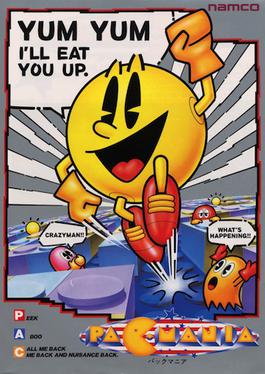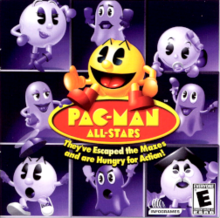
Pac-Man, originally called Puck Man in Japan, is a 1980 maze video game developed and released by Namco for arcades. In North America, the game was released by Midway Manufacturing as part of its licensing agreement with Namco America. The player controls Pac-Man, who must eat all the dots inside an enclosed maze while avoiding four colored ghosts. Eating large flashing dots called "Power Pellets" causes the ghosts to temporarily turn blue, allowing Pac-Man to eat them for bonus points.

Tom Clancy's Ghost Recon is a tactical shooter video game developed by Red Storm Entertainment and published by Ubi Soft in 2001 for Microsoft Windows. It is the first game in the Ghost Recon series. It was ported to Mac OS, Xbox and PlayStation 2 in 2002 and to the GameCube in 2003. Ports for N-Gage and Game Boy Advance were planned, but later canceled. Unlike Clancy's other tactical shooter series, Rainbow Six, Ghost Recon is not based on any of his books.

Ms. Pac-Man is a 1982 maze arcade video game developed by General Computer Corporation and published by Midway. It is a spin-off sequel to Pac-Man (1980) and the first entry in the series to not be made by Namco. Controlling the title character, Pac-Man's wife, the player is tasked with eating all of the pellets in an enclosed maze while avoiding four colored ghosts. Eating the larger "power pellets" lets the player eat the ghosts, which turn blue and flee.

Midtown Madness is a 1999 racing game developed by Angel Studios and published by Microsoft for Microsoft Windows. The demo version was released in April 1999. Two sequels followed, with Midtown Madness 2 released in September 2000 and Midtown Madness 3 released in June 2003 for the Xbox. The game is set in Chicago; the object is for the player to win street races and obtain new cars.

Pac-Man Vs. is a 2003 maze video game developed by Nintendo and published by Namco for the GameCube. In the game, one player takes control of Pac-Man, who must eat all of the pellets in the maze, while the others control the ghosts to try to catch them. The objective is to be the first to reach a set number of points, selected before the game begins. The player controlling Pac-Man uses the Game Boy Advance to play, while the others use the television to control the ghosts. The game requires the GameCube - Game Boy Advance link cable in order to play.

Super Pac-Man is a 1982 maze chase arcade game developed and published by Namco. It was distributed in North America by Midway, and is Namco's take on a sequel to the original Pac-Man; Midway had previously released Ms. Pac-Man, which Namco had little involvement with. Toru Iwatani returns as designer.

Pac-Man World 2 is a platform video game developed and published by Namco Hometek. It was released for the Xbox, GameCube, and PlayStation 2 in 2002. A version of the game for Microsoft Windows was released in 2004, and an abridged version for the Game Boy Advance was released in 2005. The game is a sequel to Pac-Man World (1999). The player controls Pac-Man in a 3D platforming environment, through six worlds. In 2005, a sequel, Pac-Man World 3, was released.

Pac-Attack, also known as Pac-Panic, is a 1993 falling-tile puzzle video game developed and published by Namco for the Super Nintendo Entertainment System and Sega Genesis. Versions for the Game Boy, Game Gear and Philips CD-i were also released. The player is tasked with clearing out blocks and ghosts without them stacking to the top of the playfield — blocks can be cleared by matching them in horizontal rows, while ghosts can be cleared by placing down a Pac-Man piece that can eat them. It is the first game in the Pac-Man series to be released exclusively for home platforms.

Ms. Pac-Man Maze Madness is a maze chase video game developed and published by Namco for the PlayStation in 2000. It was later released for the Nintendo 64, Dreamcast, and Game Boy Advance. A remake of Ms. Pac-Man (1982), players control the titular character in her quest to stop a witch named Mesmerelda from stealing the Gems of Virtue. The game was well-received upon release, with critics applauding its simplicity and faithfulness to the arcade original. A sequel was in development around 2006, but was cancelled for unknown reasons.

Pac-Man World is a platform video game developed and published by Namco for the PlayStation. Controlling Pac-Man, the player must complete each of the game's six worlds by collecting keys to free his captive family members, and reaching the end of each stage. The plot follows Pac-Man's enemies, the ghosts, crashing his 20th birthday and kidnapping his friends and family to bring them to their homeland of Ghost Island — with his birthday in ruins and his family in trouble, Pac-Man sets out to rescue them and defeat the ghosts.

Midtown Madness 2 is a 2000 open world racing video game for Windows. It is the sequel to 1999's Midtown Madness, developed by Angel Studios and published by Microsoft. Unlike its predecessor, which is entirely set in Chicago, it features two open worlds in which to race, fictional representations of San Francisco, California and London, England. Players can choose from a variety of American and British vehicles including sports cars, buses and taxi cabs. The game has various modes of multiplayer connectivity, and included support for the now defunct MSN Gaming Zone. A sequel Midtown Madness 3 was released for Xbox in 2003.

Pac & Pal is a 1983 maze chase arcade game developed and published by Namco. It is part of the company's Pac-Man series and the third to have been produced in-house. Players control Pac-Man as he must eat the items in an enclosed maze while avoiding four colored ghosts that pursue him. Pac-Man is assisted by a green-colored creature named Miru, the titular "Pal", who brings the items back to the center box. Pac-Man can also collect power-ups that allow him to briefly stun the ghosts.

Pac-Man: Adventures in Time is a 2000 maze video game in the Pac-Man series developed by Creative Asylum and Mind's Eye Productions, and published by Hasbro Interactive, in collaboration with Namco. The game follows a formula similar to the original arcade game, while expanding on it with new features. In the game, Pac-Man travels through various time periods using Professor Pac-Man's time machine to recover pieces of an ancient artifact.
Pac-Man is a video game series and media franchise developed, published and owned by Bandai Namco Entertainment, a video game publisher that was previously known as Namco. Entries have been developed by a wide array of other video game companies, including Midway Games, Atari and Mass Media, Inc., and was created by Toru Iwatani. The eponymous first entry was released in arcades in 1980 by Namco, and published by Midway Games in North America. Most Pac-Man games are maze chase games, but it has also delved into other genres, such as platformers, racing, and sports. Several games in the series were released for a multitude of home consoles and are included in many Bandai Namco video game compilations, The franchise contains 2 animated series and an upcoming film.

Pac-Mania is a cavalier perspective maze game that was developed and released by Namco for arcades in 1987. In the game, the player controls Pac-Man as he must eat all of the dots while avoiding the colored ghosts that chase him in the maze. Eating large flashing "Power Pellets" will allow Pac-Man to eat the ghosts for bonus points, which lasts for a short period of time. A new feature to this game allows Pac-Man to jump over the ghosts to evade capture. It is the ninth title in the Pac-Man video game series and was the last one developed for arcades up until the release of Pac-Man Arrangement in 1996. Development was directed by Pac-Man creator Toru Iwatani. It was licensed to Atari Games for release in North America.

Pac-Man Championship Edition is a 2007 maze video game developed and published by Namco Bandai Games for the Xbox 360. It has since appeared on several other platforms, including iOS, Android, and the PlayStation 3 and PlayStation Portable as a PSP mini title available on the PlayStation Store. It is an HD reimagining of the original Pac-Man arcade game; players navigate Pac-Man through an enclosed maze, eating pellets and avoiding four ghosts that pursue him. Clearing an entire side of the maze of dots will cause a fruit item to appear, and eating it will cause a new maze to appear on the opposite side.

Pac-Man Championship Edition DX is a 2010 maze video game published by Namco Bandai Games for the Xbox 360 and PlayStation 3, later ported to Steam, Android and iOS. It is the sequel to the 2007 game Pac-Man Championship Edition, which was the last game developed by series creator Toru Iwatani. The player controls Pac-Man as he must eat all of the dots in the maze while avoiding colored ghosts that pursue him. A bonus item will appear once the player has eaten all dots on one side of the maze, causing the layout to change. Several additions were made over the original, such as bombs that send all ghosts to the regeneration box and sleeping ghosts that will give chase when Pac-Man moves past them.

Pac-Man 256 is an endless runner video game developed by Hipster Whale and 3 Sprockets and published by Bandai Namco Entertainment. The game is part of the Pac-Man series and is inspired by the original Pac-Man game's infamous Level 256 glitch, as well as Hipster Whale's own game Crossy Road, which previously featured a Pac-Man mode. The game was originally released as a free-to-play title for iOS and Android on August 20, 2015. In June 21, 2016, Bandai Namco Studios Vancouver released a version of the game for the PlayStation 4, Xbox One, and PC, featuring additional features like multiplayer for up to 4 players, a new power-up, and no longer having to wait a certain amount of time to get power-ups, and instead having to eat a number of Pac-Dots.

Pac-Man Championship Edition 2 is a maze arcade game developed by Bandai Namco Studios and published by Bandai Namco Entertainment. An installment in the Pac-Man series, it was released for PlayStation 4, Windows, and Xbox One on September 15, 2016; an updated version featuring an exclusive 2-player co-op mode, Pac-Man Championship Edition 2 Plus, was released for Nintendo Switch on February 22, 2018. It is a direct sequel to Pac-Man Championship Edition and the follow-up of Pac-Man Championship Edition DX+.

Pac-Man 99 was a maze video game with battle royale elements developed by Arika and published by Bandai Namco Entertainment for the Nintendo Switch. It was released through the Nintendo Switch Online service on April 7, 2021.



















